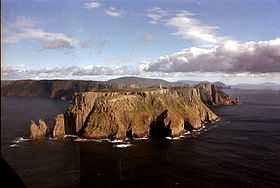Tasman Island
.jpg)

Tasman Island is an oval island, with an area of 1.2 km2, in south-eastern Australia. It is part of the Tasman Island Group, lying close to the south-eastern coast of Tasmania around the Tasman Peninsula, and is in the Tasman National Park. It is a plateau surrounded by steep dolerite cliffs, with its highest point 300 m asl and an average plateau height of 280 m asl. It is the site of the Tasman Island Lighthouse and weather station, which has been automated since 1976 and unmanned since 1977.[1][2]
Flora and fauna
Plants
The island was once thickly forested. The forest has largely disappeared as a result of cutting the trees for firewood and of intense fires.[2] When the lighthouse was manned the keepers kept livestock, including cattle, sheep and draught horses, and maintained grassland for their grazing. Areas of grassland remain along with other vegetation communities of heathy scrub, regenerating scrub, sheoak woodland, sedgeland and coastal mosaic. An important plant present is the rare Cape Pillar Sheoak (Allocasuarina crassa).[3][4]
Birds

Tasman Island is a very important breeding site for Fairy Prions, with an estimated 300,000-700,000 pairs, making it the largest such colony in Tasmania, and possibly in Australia. It has been identified as an Important Bird Area (IBA) by BirdLife International because it supports over 1% of the world population of the species.[5] Other recorded breeding seabird species are Little Penguin (now extinct there as a breeding species), Short-tailed Shearwater and Sooty Shearwater. The Swamp Harrier has also bred on the island.[1][3]
The breeding seabirds were preyed on by a feral cat population estimated at about 50, feeding mainly on Fairy Prions and taking about 50,000 birds annually. The cats were eradicated by a baiting, trapping and hunting program carried out in May 2010.[6][3][7]
Other animals
Australian and New Zealand Fur Seals use the rocky shore as a haul-out site, and the latter species has bred there in small numbers. Humpback Whales pass through the surrounding waters. Reptiles recorded from the island include the Metallic Skink, White's Skink, Spotted Skink and She-oak Skink. A notable invertebrate, so far recorded only from Tasman Island, is the cricket Tasmanoplectron isolatum.[1][3]
See also
References

- ↑ 1.0 1.1 1.2 Brothers, Nigel; Pemberton, David; Pryor, Helen; & Halley, Vanessa. (2001). Tasmania’s Offshore Islands: seabirds and other natural features. Tasmanian Museum and Art Gallery: Hobart. ISBN 0-7246-4816-X
- ↑ 2.0 2.1 "Tasman Island Lighthouse". Lighthouses of Tasmania. Lighthouses of Australia Inc.
- ↑ 3.0 3.1 3.2 3.3 Bryant, S.L.; and Shaw, J. (Eds). (2006). Tasman Island: 2005 flora and fauna survey. Hamish Saunders Memorial Trust, New Zealand and Biodiversity Conservation Branch, DPIW, Hobart, Nature Conservation Report Series 06/01. ISBN 9780724664276
- ↑ "Allocasuarina crassa". Threatened Flora of Tasmania. Department of Primary Industries and Water, Tasmania. Retrieved 2011-11-03.
- ↑ "IBA: Tasman Island". Birdata. Birds Australia. Retrieved 2011-11-01.
- ↑ "Feral cats eradicated from Tasman Island". News release. Parks and Wildlife, Tasmania. 2011-06-01. Retrieved 2011-11-01.
- ↑ Restoring the Natural Values of Tasman Island
Coordinates: 43°14′S 148°00′E / 43.233°S 148.000°E